Public safety for dam owners
Best management practices for dam owners. Includes guidance on the identification of public safety hazards associated with dams, and how to eliminate or mitigate these hazards.
Ontario Ministry of Natural Resources
August 2011
This publication is available online at: Dam management
The Lakes and Rivers Improvement Act (LRIA) provides the Minister of Natural Resources with the legislative authority to govern the design, construction, operation, maintenance and safety of dams in Ontario. These best management practices have been prepared to provide Ontario dam owners with guidance on the safe management of dams. These best management practices are recommendations only and are not to be considered when seeking approval under Section 14, 16 and 17.2 of the LRIA.
1.0 Introduction
These best management practices have been prepared to provide dam owners with guidance on the identification of public safety hazards associated with a dam, and the measures that can be taken by the owner to either eliminate or mitigate these hazards.
Addressing public safety around dams requires addressing both the physical structure and the dam’s operation, particularly as it relates to discharging water. This includes associated upstream and downstream hazardous conditions resulting from the discharge of water.
Public safety measures implemented to eliminate or mitigate the public’s exposure to hazards include physical barriers, operating controls, warning systems, signage as well as initiatives designed to raise public awareness and understanding of the potential hazards. For reference purposes, typical practices for the design, installation and maintenance of public safety measures have been included as an Appendix to this guideline.
These best management practices are not designed to apply to:
- Mine Tailings Dams;
- Dams less than one (1) metre in height; or
- Dams located on private land that are situated on non-navigable waterway to which there is no public access by either land or water.
1.1 Why are issues of public safety around dams important?
Dam safety has traditionally been associated with protecting the public from catastrophic failure resulting from unusual loading conditions and extreme events. However, an important aspect in meeting the principles regarding the safe management of dams throughout their life cycle is to guard the public from hazards associated with the dam and its operations.
Dam owners and operators should be aware of both known and potentially significant public safety hazards associated with these structures, their operation and how it impacts the surrounding area. Once these hazards have been identified, public safety measures, commensurate with the potential hazard, should be taken to either eliminate or mitigate the hazard.
1.2 Who is responsible for public safety around dams?
Dam owners are responsible for the safe operation and maintenance of their dams. Part of safe operation and maintenance is a responsibility to implement appropriate public safety measures to address potential exposure to hazards created by the dam and its operation.
Where required, design work associated with the implementation of physical public safety measures should be carried out by a Qualified Engineer (e.g. support systems for freestanding signs, safety booms and anchorage systems).
2.0 Managed system approach
2.1 What should dam owners be doing?
The public safety wheel:
Dam owners should adopt a managed system approach to address the potential hazards to the public that are associated with dams and their operations. The ‘Public Safety Wheel’ (Canadian Dam Association - Dam Safety Guidelines: Public Safety Around Dams Technical Bulletin), Figure 1 illustrates the elements of public safety management that involves planning, implementing, checking, revising and reporting.
In adopting such an approach, owners will build into their management systems a cyclical process that insures follow up to any public safety issues. As part of the process, owners will undertake a routine review of the hazards and the measures taken to safe guard the public.
Figure 1 – The public safety wheel: a managed system approach to public safety around dams
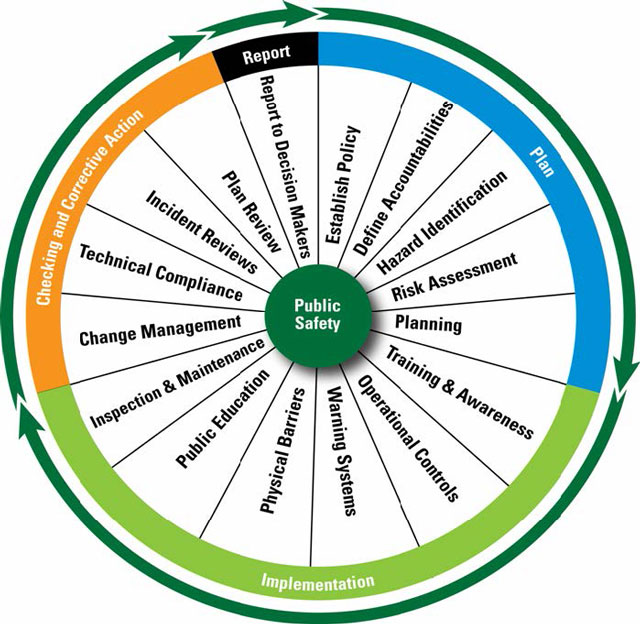
(Source: Canadian Dam Association – Technical Bulletin: Public Safety Around Dams)
3.0 Public safety assessment
3.1 Why conduct a public safety assessment?
Dam owners should undertake a formal Public Safety Assessment (PSA) of the dam and its appurtenant facilities and operations to identify potential public safety hazards. The assessments should be conducted by a competent person, who has the necessary knowledge, experience and training to recognize public safety hazards and the appropriate means to address them.
The PSA is conducted to determine whether a Public Safety Plan (PSP) should be developed. The PSA should consider:
- The type and location of hazards created by the dam and its operation, including:
- hazards created by the nature of the design of the dam (e.g. vertical surfaces which may be a hazard for falls);
- weir type structures capable of passing water, where there is a potential hazard to public safety created by the submerged hydraulics associated with the overflow. These types of weir structures are commonly referred to as “drowning machines” wherein the overflow waters continuously re- circulate at the base;
- hazards created as a direct result of the dam’s operations, in regard to rapid changes in flows and/or levels; and
- hazards created by swift currents through intake channels and spillways.
- The consequences and likelihood of hazard being realized; and
- The seasonal nature and extent of the public activities occurring at the site.
- The type and location of hazards created by the dam and its operation, including:
- Where a hydraulic assessment is required to confirm that conditions described in 1 (a) (ii) (iii) (iv) (above) present a hazard to the public, the results should be documented and retained for reference. The documentation should be such that the dangerous waterway zones are clearly identified, including the conditions which would generate hazardous water flows and levels.
The PSA should be retained as a document by the dam owner. Dams that do not present a hazard to the public should as a minimum have a letter signed and dated by a competent person indicting that there is no need to prepare a PSP. A sample letter is included in Appendix F.
Where a PSA has not resulted in the preparation of a PSP, the site should be revisited every 10 years to determine if site conditions, or activities around the site have changed and the PSA updated accordingly. The updated PSA should be retained by the dam owner for another 10 year period.
3.2 Assumptions for public safety assessments
The following should be considered:
- Physical barriers are intended to act as deterrents and are not designed to prevent access from those seeking to unlawfully gain access to an owner’s property or controlled areas;
- Installation of signs or physical barriers are not intended to address naturally occurring hazards; both water based (e.g. rapids, submerged boulders, etc.) and landforms (e.g. cliffs) that occur on lakes and rivers and at dam sites and waterpower facilities;
- Recreational use of waterways (e.g. boating, swimming, etc.) is assumed to occur during periods of the year when the reservoir/river is ice free (i.e. does not occur when there is floating ice in the waterway) or has been otherwise designated for use by the authorities. Winter recreational activities such as ice fishing, snowmobiling and skiing can also occur upstream of water control structures.
- Partially open water and cracked ice is part of normal river/reservoir conditions from late fall through spring seasons and no special protective measures are required to address these hazards;
- Illumination of signs and barriers is intended to come from the motorized vehicles and watercraft that may be operated outside of daylight hours or other periods of low visibility; and
- The public’s safe exit from an area will be based on normal healthy individuals and will be assumed to begin on the first alert from the audible sirens or warning lights, where provided.
4.0 Public safety plan
4.1 General
A PSP should be prepared once the dam owner has completed a PSA and determined that a public safety hazard exists.
The PSP should include a summary of the completed PSA which documents the hazards associated with the dam that may be encountered by the public.
The dam owner should ensure that a competent person prepares the PSP and that it is reviewed on a routine basis to record changes which may occur at the dam. Dam owners should review and update the PSP periodically or following any major changes occurring at the site that are likely to affect public safety. Reviews of the PSP should also be undertaken if the owner’s assumptions upon which the PSP are based change as determined by observations of public interaction and incidents at the site.
The PSP should recognize the unique characteristics associated with the dam and its operation.
The PSP, and all revisions, will be signed by the dam owner and the competent person who has prepared the PSP.
4.2 What should the public safety plan contain?
The Public Safety Plan should include the following components:
- Signature Box;
- Accountability: Summary of roles and responsibilities for the operating personnel as they relate to public safety;
- Site Description;
- Summary of the Public Safety Assessment (PSA);
- Public Safety Measures:
- A summary of any operating practices and control measures that will be taken to either eliminate or mitigate the public exposure to the hazard; and
- A list of all installed physical control measures;
- Inspection & Maintenance Schedule: A summary of inspection and maintenance requirements for the public safety control measures;
- A summary of any site specific initiatives that promote public safety awareness of the hazards present at the site;
- Record management requirements covering review periods, retention, and the Dam owner’s approval; and
- Incident Reporting.
4.2.1 Signature box
A signature box should be included at the beginning of the PSP and should appear as follows:
4.2.2 Accountability
As part of the PSP dam owners should document:
- The roles and responsibilities of individuals. This includes managers, employees and others with a specific role relating to the PSP;
- The planning and execution of all site-specific maintenance and inspection activities;
- The training requirements of the PSP;
- The process for both recording and reporting incidents involving the public;
- The owners process to evaluate systemic incidents;
- The routine review and update of the PSP; and
- Changes at the site and/or changes in the degree of public interaction in terms of the potential impact on public safety.
4.2.3 Site description
The Site Description should include the following information:
- A written description detailing:
- Land tenure; and
- Adjacent areas administered by other jurisdictions, such as recreation areas, conservation authorities, or Crown agencies.
- A detailed map, to scale, showing the location of the dam and its associated appurtenant facilities and surrounding area. This map should include:
- The site property boundaries, where known, including roads, portages, or public trails;
- The location of all public safety measures including signs, booms, buoys, guard rails, sirens and warning lights to assist in their ongoing inspection and maintenance;
- The location of dangerous areas immediately above and below and at the dam; and
- The location of specific upstream and downstream hazards as a direct result of the dam operations.
4.2.4 Public safety assessment
A summary of the completed PSA should be included in the PSP. This should include brief summaries of the:
- Extent of the area included in the assessment;
- Specific locations of hazards which are known to result directly from the existence or operation of the dam; and
- Known public interactions, both anecdotal and documented.
4.2.5 Public safety measures
The public safety measures section of the PSP should describe all the existing and new physical and operating control measures.
Dam operating procedures should contain a summary description of the opening and closing procedures of the dam discharge facilities and how this mitigates the identified hazards. For sites that include sirens and warning lights, dam owners should provide a description of how their use is integrated with the operation of the dam.
Where new measures have been identified, they should be detailed with the implementation schedule and appended to form part of the PSP.
4.2.6 Inspection and maintenance requirements
The inspection and maintenance requirement section should include:
- The frequency of regularly-scheduled inspection and maintenance cycles (to be conducted at least on an annual basis) required to ensure that the physical public safety measures installed or implemented continue to remain operational;
- Documentation as to how the accumulation of debris will be managed at the site to insure it does not interfere with the physical control measures;
- A summary of how the owner will repair or replace damaged physical control measures including any interim safety measures that will be implemented while measures are being repaired or replaced; and
- For each public safety measure inspected, inspection records should identify:
- Date of inspection;
- Name of person performing inspection;
- Public safety measures inspected and their condition;
- Corrective actions necessary;
- Confirmation of any corrective actions completed; and
- Whether each of the public safety measures represent current practice.
4.2.7 Initiatives that promote public safety awareness
Initiatives that promote public safety awareness should be documented in the PSP where they are specifically required as part of the plan to warn the public who may have access to the site.
4.2.8 Record management
As part of the dam owner’s managed system for public safety the documentation requirements should be clearly defined, including the retention period for such items as:
- The PSA;
- The PSP;
- Inspection and maintenance records;
- Incident Records; and
- Amendments to the PSP.
Dam owners should retain all records and documents for a minimum of two PSP review cycles.
4.2.9 Incident reporting
Dam owners should document any safety incidents involving members of the public (including “near misses”) and use this documentation to inform the review and update of the PSP.
Each incident report should contain information pertaining to the date, location and approximate time of the incident as well as the type of incident, the activities and sequence of events that led to the incident as well as a description of any resulting injury.
5.0 Public safety measures
5.1 What are public safety measures?
Public safety measures consist of actions that are taken to either:
- Take reasonable precautions to eliminate the hazard;
- Where the hazard cannot be eliminated, take reasonable precautions to mitigate the hazard; or
- For any remaining hazard, take reasonable precautions to control the public’s exposure to the hazard.
Actions can include operating practices that are implemented and/or physical devices that are installed by the owner.
Public safety measures to be considered by the owner, include such items as:
- Signage to warn the general public of the hazards and the action to take;
- Physical safety measures to restrict access (fences, railings, guard rails, booms, buoys);
- Operating practices and/or warning systems to alert the public of the hazard (sirens and warning lights);
- Emergency response procedures with local emergency response agencies that focus on public safety; and
- Public education of the hazards associated with the dam.
Where public safety measures are in place that do not represent current or emerging practices, the dam owner should consider updating them to the new standard or practice when they are being replaced.
See Appendix for further information on public safety control measures.
5.2 Operating practices as control measures
Where reasonable, operating practices can be used effectively to either eliminate or mitigate the hazards to the public by gradually introducing changes in flows and levels or visually inspecting the dangerous area immediately downstream of a dam before releasing water.
Dam owners may be able to mitigate the hazards to the public through the use of operating procedures such as:
- Staged opening of gate operations to minimize the rate of change for inflows and water levels in the spillway channel and downstream areas;
- Operating gates in a prescribed sequence;
- Sounding audible sirens or activating flashing strobe lights to warn the public of pending changes; and
- Conducting visual inspections of spillways prior to inflows and levels operations.
5.3 Physical control measures
Physical control measures can be used to control the public’s exposure to the hazard through the use of warning systems such as signage, sirens and warning lights.
Hazards to the public can also be mitigated by restricting public access to the dam through the use of physical safety measures, including fences, railings, safety booms and buoys.
5.3.1 Signage
Signage is a primary means of informing the public of hazards associated with dams. It is important that signs convey a message that is consistent with the degree of risk presented to the public. In general there should be two primary distinctions in signs used at a site to identify hazardous areas; those used to identify dangerous areas and those intended to identify warning areas.
The installation of signs needs to recognize the site-specific conditions. The development of message wording, installation methods, material used, and choice of pictographs require proper planning to be effective.
The elements of effective signs are:
- The message is concise and easily understood;
- Signs are consistent with respect to colour, size, format and messaging;
- Signs are properly located and installed;
- Signs are regularly inspected. Old, damaged and/or vandalized signs are replaced and new signs installed as needed; and
- The message text on the sign is sized to the viewing distance.
While the location of the signs is specific to the site conditions the following is intended to provide some guidance as to the placement:
Public portage routes
Appropriate signage should be provided to safely guide the public around hazardous areas within the owner’s property boundaries.
Sign location & size
Signs should be located where specific public safety hazards are identified (e.g. spillways, intakes, discharge locations, points where there is a potential of a vertical fall and around operating equipment where there is a potential for the public to gain access).
Signs should be:
- Positioned where they provide adequate time for viewer response, considering such factors as approach speed. In some cases, it may be appropriate to install a warning sign (Appendix C Figure C.8 or 9) a suitable distance before a danger sign;
- Visible from a safe viewing distance along normal access routes to the dam from land and water. The overall dimension of the sign, as well as the text size should be such that the message can be clearly read from beyond the hazardous area and takes into account the speed at which the hazard is approached. See Appendix A Figure A.2 for determining the message text size for the viewing distance; and
- Installed to advise the public of the meaning of sirens and warning lights that are in place at the site. These signs can be stand-alone signs but should be mounted directly below or adjacent to existing waterway hazard signs.
Where dangerous areas exist at the dam site, on the dam owner’s property, signs should be erected indicating the presence of the danger. In the case of the dangerous area being a portion of a navigable waterway, the signage should advise the public to “Keep Out” or “Keep Away”. The dam owner does not have the right to prohibit access to any portion of a navigable waterway unless approval exists under the Vessel Operation Restriction Regulations of the Canada Shipping Act.
In all cases the signs should be able to be clearly read from outside the hazardous area.
Sign specifics
The following elements are to be considered when developing a sign to designate a hazardous area at a site.
A consistent colour coding should be used:
- Red with white lettering should be used for dangerous areas where there is a risk of critical injury or death. These signs should clearly indicate the public should not access this area;
- Yellow with black lettering to be used for warning areas where the public is allowed to access but where there is risk of minor injury or as an advanced warning; and
- Colour quality should adhere to best management practices to achieve visibility under in-direct lighting.
The use of symbols and/or pictographs on signs should be consistent with internationally recognized markers.
Pictographs, where used, should act to supplement the text message and not as a replacement, in clearly identifying the public safety hazards.
Signs should meet the language requirements as specified under the French Language Services Act (Provincial) as well as consider other languages used in the surrounding community.
Where signs are required at a site, at least one sign should contain the name of the facility, operator and an emergency contact number to assist with response and rescue.
Sign installation
Signage is to be installed in accordance with standard engineering practices that address such issues as the loading conditions to which they will be subjected to (e.g. wind loads).
Changing reservoir levels or snow accumulation may influence the location and mounting height of the sign.
Signs should not be installed using suspended cables over a navigable waterway as this practice often poses a danger to watercraft or snow machines.
5.3.2 Sirens and warning lights
Sirens and warning lights should be considered for use in conjunction with remotely or automatically operated spillway gates which may introduce a public safety hazard due to rapid changes in water levels or flows.
Alternatives to the use of sirens and warning lights would include:
- Operating the spillway gates such that the hazard is eliminated by gradually introducing the changes in flows and levels such that the public is aware that the changes are occurring;
- Providing site surveillance in advance of the spill operation to insure the public is not present in the dangerous area, i.e., downstream channel or immediately upstream of the spillway gate; and or
- Installing physical barriers to restrict public access to the dangerous area.
The local site specific requirements need to be considered when determining if a siren and/ or warning lights are to be installed. For example the proximity of permanent residents may imply that warning lights are more appropriate than sirens in providing advance warning of a spill operation.
In instances where sirens and/or warning lights are utilized in conjunction with spillway gate openings, the control logic system for the spillway gate should be integrated such that the timing and duration of the warning device and lapse period prior to opening and subsequent operation of discharge facilities is sufficient to provide the public adequate time to exit from the dangerous area.
The audible warning signal should:
- Clearly be heard at the extent of the dangerous area in which persons are intended to recognize and react to the siren; and
- Convey a level of urgency, and be unlike any other audible signals used at the facility.
The location / audible rating of the siren should not allow any member of the public to be exposed to 115dB(A) or higher.
Audible warning signals are not to be confused with an audible emergency evacuation signal. The audible emergency evacuation signal is a specific temporal three pattern (T3) which is defined under its own International Organization for Standardization (ISO) Standard 8201. The audible emergency evacuation signal (T3) has been reserved in Canada by the National Building Code for building fire alarms and should not be used.
Should a siren be required at a dam site, it is recommended that the audible warning be a “slow whoop” signal.
It is also important to install signs to inform the public of the meaning of the signs and alerts and give direction as how to appropriately respond.
5.3.3 Fences and railings
Machinery and equipment associated with the operation of the dam that could present a danger to the public should be fenced or enclosed to prevent public access.
Where a vertical fall at a dam creates a potential hazard, hand railings, guard rails, or fencing should be installed consistent with the Ontario Building Code where the public has access. This does not apply to natural topographic features of a site (e.g. rock cliffs, embankments).
5.3.4 Safety booms and buoys
Safety booms or buoys can be used to delineate warning zones across waterways in order to deter access by the public to the dangerous water area.
It should be noted that safety booms are also subject to federal approval under the Navigable Waters Protection Act (NWPA) and that buoys are subject to the Private Buoys Regulation under the Canada Shipping Act.
Safety booms and buoys are intended to delineate the dangerous area and to discourage boaters and/or swimmers from entering dangerous waters.
Adequate colour and freeboard are essential to the success of booms and should be considered by the dam owner in consultation with Transport Canada.
Installation, removal & storage
Site-specific conditions and the NWPA approval will govern the exact location of the safety boom.
To the extent practical, safety booms should be designed such that:
- In the event that the boom fails, the maximum length from the anchor point to the failed section will not allow the boom to enter the spillway of the dam, thereby preventing the removal of stoplogs;
- The orientation facilitates debris removal; and
- The orientation improves the opportunity for the public to “self-rescue”.
When installing and removing booms, the dam owner’s practices should be reviewed to ensure that these activities do not introduce additional public safety hazards.
The time of year and level of public use should be taken into consideration when installing safety booms.
Debris booms
Debris collection booms may be modified for use as a safety boom. This can be accomplished by installing buoys either immediately upstream or as part of the debris boom to warn boaters of the boom location.
Approvals
All safety booms and buoys are to meet municipal, provincial, and federal regulations for installation and navigation.
All booms, water control structures and any repairs, or alterations on a navigable waterway must be approved under the NWPA or at the direction of Transport Canada.
Any non-government buoys (those not installed by the Canadian Coast Guard) would be subject to the Private Buoys Regulation under the Canada Shipping Act in regard to size, colour and markings specifications.
Anchorages may require approval from Fisheries and Oceans Canada (DFO) and the MNR.
Additional approvals may be required where work is being completed within the jurisdiction of a conservation authority or any other regulated area.
Appendices
Appendix A: Signage
The following information is provided as additional guidance.
A.1.1 Design and construction of signs
All sign installation procedures should recognize varying site-specific conditions. The development of message wording, installation methods, material used, and choice of pictographs require proper planning to be effective.
Materials
The signage should:
- Be constructed of aluminum material;
- Have a safety radius for the corners of the sign; and
- Be visibility enhanced in low-light conditions, through reflective background and lettering.
Sign colours
- Red colour should be similar to Pantone® Matching System (PMS) 485 Red
- Yellow colour should be similar to Pantone® Matching System (PMS) 123 Yellow.
A.1.2 Format
Sign format should be consistent with the following (see Figure A.1):
- The format of a sign should consist of a headline text at the top and have a message text in the centre.
- Headline text height should be 1.5 times the height of a capital letter of one line of “message text” in bold font or equivalent and capitalized.
- Message text should be in bold font or equivalent, with the first letter of each word capitalized.
- All text on the sign should be left-aligned except for the company logo in the bottom right hand corner.
- Large signs may have the facility name and 24-hour emergency contact phone number located on the bottom left corner of the sign in the white protected space.
- The white protected space at the bottom of all signs should be equal in height to a single line of message text.
A.1.3 Message
Messaging should be clear and effective by following these standards:
- Where there is a potential danger of critical injury or death, dam owners should place red Danger signs on waterways immediately upstream and downstream of a structure.
- Signs should convey a clear message, denoting the hazard and the action to be taken (e.g. Dam Ahead – Keep Out, in advance of the hazard to enable a boater to react accordingly).
- In the event that a hazard or action identified at a site differs from the hazards and associated actions described in the signage examples, below a message text should be developed to accurately reflect the site specific hazard and required action.
- Signs should meet the language requirements under the French Language Services Act (Provincial).
Figure A.2 should be followed when determining the size of lettering for the message text based on necessary viewing distance from a sign.
A.1.4 Pictographs
The use of pictographs on signs, though optional, should be considered by the dam owner:
- Pictographs, if used, should be of a size equal to or greater than the size of a capital letter of the message text and they should be used in conjunction with message text and not as a replacement for it.
- Pictographs should be placed on a white background.
- For the installation of new signs, it is recommended that hazard based pictographs be used instead of restricted activity based pictographs
- When pictographs are used on signs, it is preferable that they be located vertically on the left side of the sign. Alternatively, they can be located horizontally across the bottom of the sign.
Figure A.1: Text height and format of signs
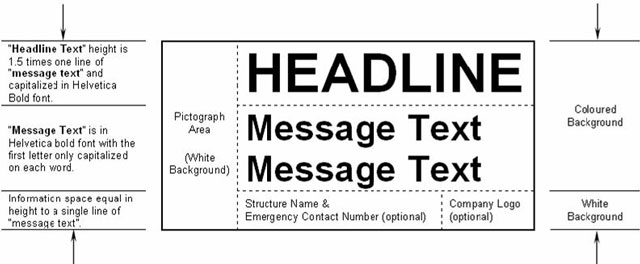
Figure A.2: Minimum size of letters
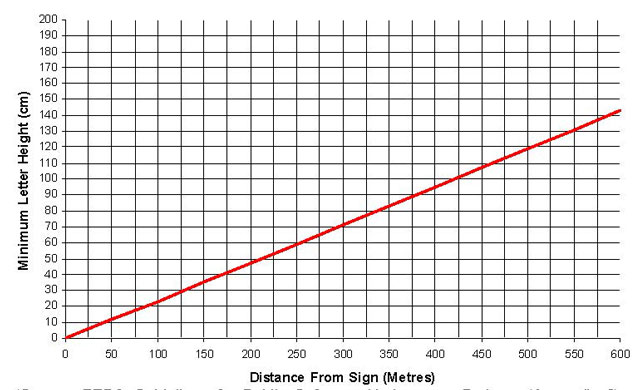
(Source: FERC Guidelines for Public Safety at Hydropower Projects (Appendix 2) -1992)
Appendix B: Signage examples
Note
- The following red danger signs use the words “Keep Out” to identify waterway areas where the public is advised to stay out of for their safety. These signs are placed at the extent of the dangerous waterway area to clearly delineate it (Figure B.1)
- In the rare instances where danger signs cannot be placed out at the extent of the dangerous waterway area, (i.e., not bounded by land on the side), wording indicating “Keep Away” may be used.
- Wording indicating “No Trespassing” is used where access to the dangerous waterway area across land is prohibited under the Trespass to Property Act.
- Recommended locations of siren sign (Figure B.2), if required, and optional pictograph panel (Figure B.3) are as shown below:
Figure B.1: Primary sign only
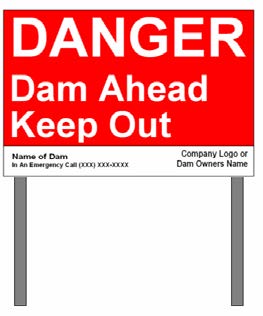
Figure B.2: Primary sign with siren sign mounted below

Figure B.3: Primary sign with siren sign mounted below and optional pictograph panel on the left
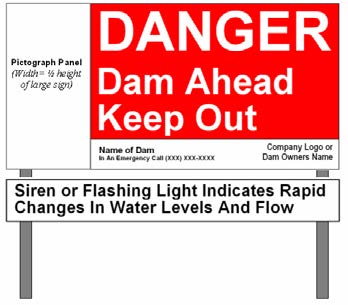
Appendix C: Large waterway signs
Figure C.1: Danger sign – dam ahead
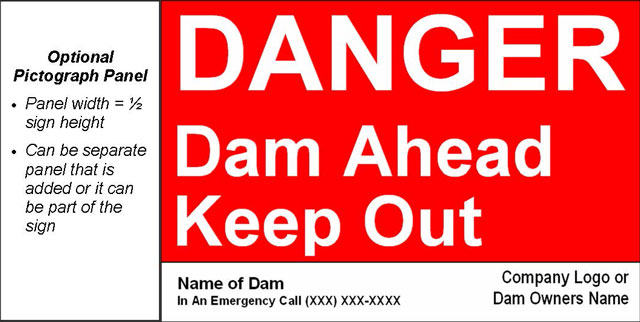
Figure C.2: Danger sign – dam outflow
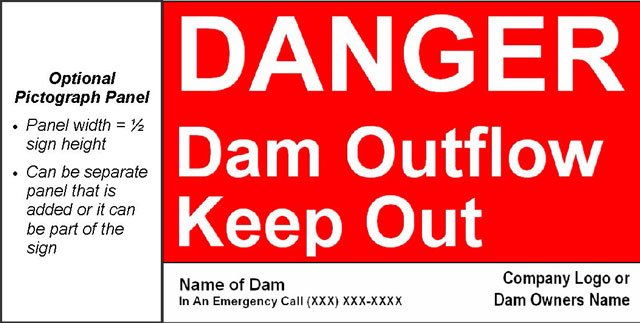
Figure C.3: Danger sign – dam upstream
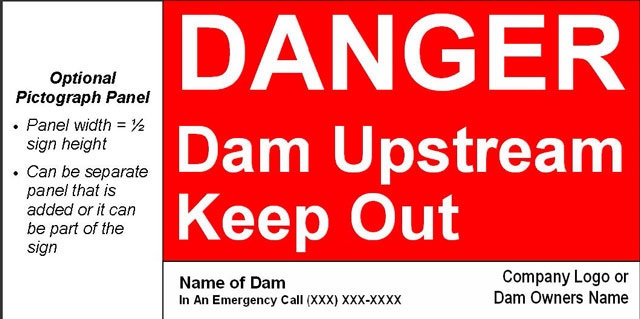
Figure C.4: Danger sign – dam ahead - drowning
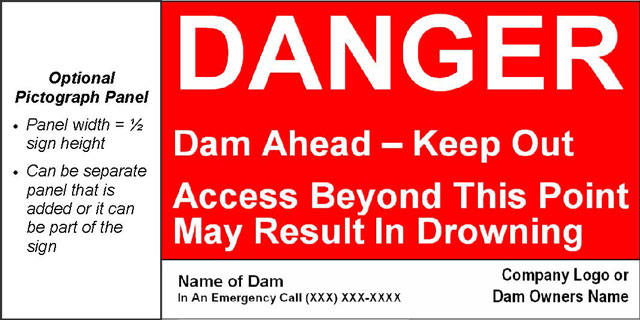
Figure C.5: Danger sign – dam outflow - drowning
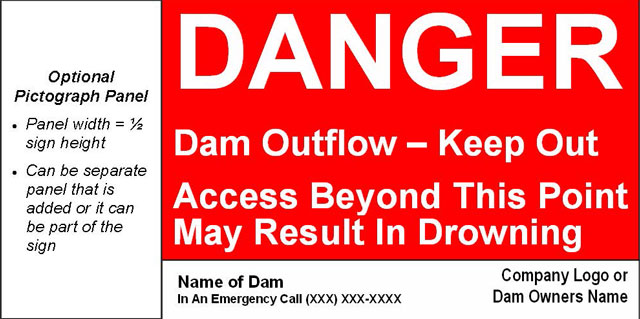
Figure C.6: Danger sign – dam upstream - riverbed floods
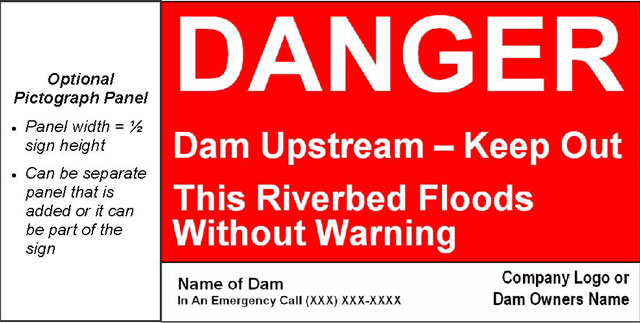
Figure C.7: Danger sign – dam ahead - swift currents and undertow

Figure C.8: Warning sign - dam upstream
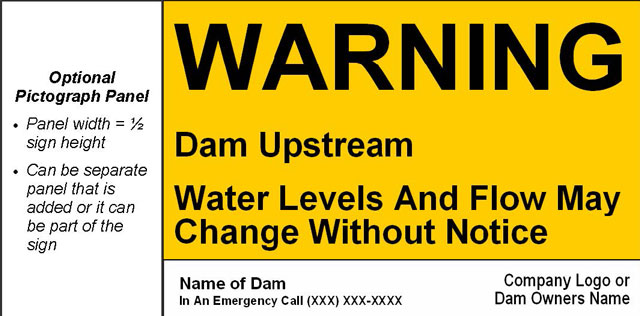
Figure C.9: Warning sign - dam downstream
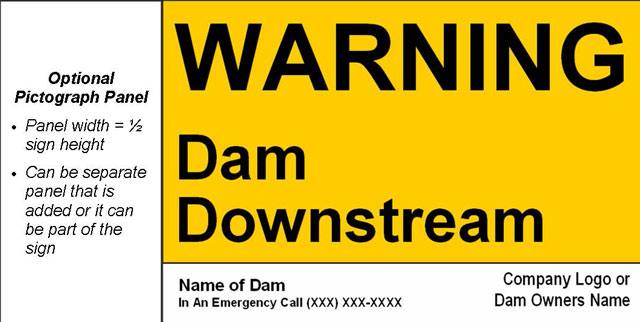
Figure C.10: Danger sign - dam crest (4 ft. x 4 ft. facing approaches by land)

Figure C.11: Audible or visual alarms sign

Note: These signs would be added to the bottom of a “Waterway” sign. The height of both the sign and the lettering is proportional to the length which matches the length of the waterway sign.
Appendix D: Small signage
Note: Small signage is typically considered to be 18 inches or 24 inches wide and is installed on “T” posts or fencing.
Figure D.1: No trespassing signs
a)

b)
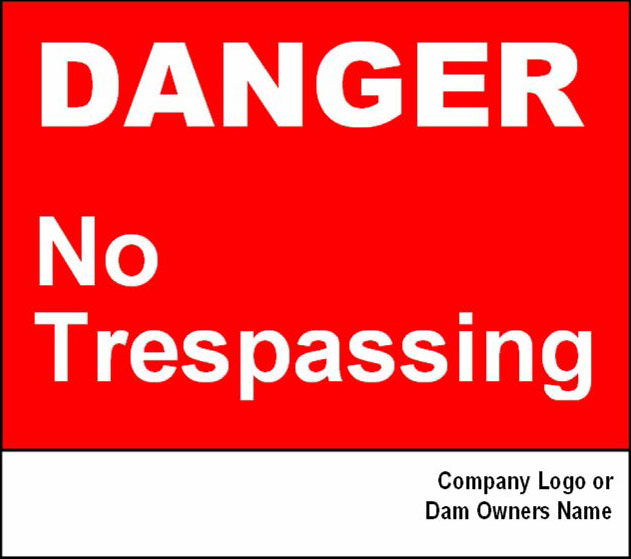
Note: Red, “Danger - No Trespassing” signs should be used to delineate prohibited access across land to dangerous waterway areas.
Figure D.2: Danger signs - drowning
a)

b)
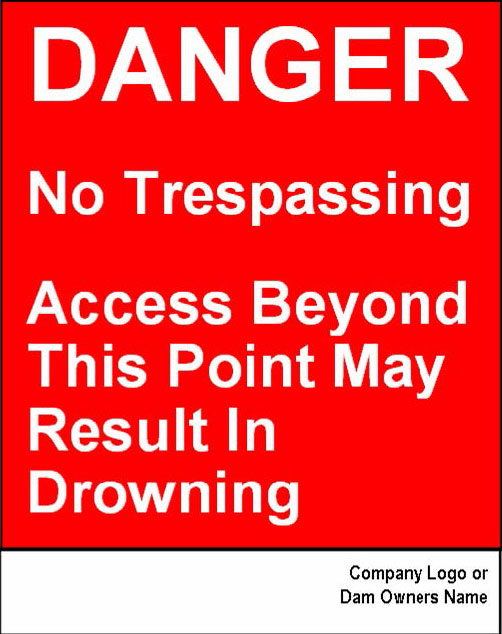
Appendix E: Sample template for public safety plan
Authorization
This document has been developed to document the Public Safety Plan at ______ (Name of site).
Prepared by: (Name of Competent Person, Position, Date) Approved by: (Name of Dam Owner, Position, Date)
1. Purpose
Identify the purpose of the Public Safety Plan and the scope of the document.
2. Accountabilities
Identify individual responsibilities for public safety for the facility. Include managers, employees or any individuals with specific roles relating to public safety in regards to:
- Ownership of the Public Safety Plan;
- Development of the Public Safety Plan, including identification of hazards and assessment of risks posed by operations of the dams and hydropower facilities;
- Implementation of the Public Safety Plan including planning and execution of all site-specific maintenance and inspection activities;
- Ensuring that site and operating personnel are trained in the requirements of the Public
- Safety Plan and aware of their responsibilities, including both reporting incidents involving the public and identification of additional hazard; and
- Investigating incidents and monitoring compliance with the Public Safety Plan.
3. Description
The Site Description should include the following information.
- A written description detailing:
- land tenure; and
- adjacent areas administered by other jurisdictions, such as recreation areas, Conservation Authorities, or Crown agencies.
- The operational procedures used to discharge water at the dam or a reference to the relevant documents.
- A brief summary of the hazards to the public present at the site including:
- the extent of the established dangerous area(s) immediately upstream and downstream of the structure; and
- specific locations that are known to be hazardous as a direct result of the existence and operation of the dam or its appurtenant facilities;
- A detailed map, to scale, showing the location of the dam and its associated appurtenant facilities and surrounding area. This map should include:
- the site property boundaries, where known, including roads, portages, or public trails;
- the location of all public safety measures including signs, booms, buoys, guard rails, sirens and warning lights to assist in their ongoing inspection and maintenance;
- the location of dangerous areas immediately above and below and at the dam; and
- the location of specific upstream and downstream hazards as a direct result of the dam operations.
4. Public safety assessment
Provide a summary of the Public Safety Assessment identifying the dangerous waterways zones, as well as areas where warnings are appropriate.
5. Hydraulic assessment results
If appropriate, provide a brief summary of the Hydraulic Assessment results and reference the reports and location where they are filed.
6. Public safety measures
Describe all the existing and new physical and operating control measures used at the site, including: signs, booms, buoys, audible alarms, strobes, fencing and access gates.
Dam operating procedures should contain a summary of the description of the opening and closing procedures of the dam discharge facilities and how this mitigates the identified hazards. For sites that include sirens and warning lights, dam owners should provide a description of how their use is integrated with the operation of the dam.
Where new measures have been identified an implementation plan should be provided.
7. Inspection and maintenance program
Provide details of an inspection program, identifying hazards and control measures inspected, frequency of inspection, means of recording inspections and the correct reporting procedure to address deficiencies when identified.
- Provide details of the maintenance program. Identify any schedules established for routine repairs or improvements.
- For each hazard/control measure inspected, inspection records should identify:
- Date of inspection;
- Name of person performing inspection;
- Control measures/devices inspected and their condition;
- Corrective actions necessary; and
- Confirmation of any corrective actions completed.
8. Public education plan
Describe any specific initiatives required to either notify the public or raise their awareness in regards to hazards identified at the site.
Appendix F: Sample letter for file for dams that do not have any public safety hazards
(Date: XXXX-XX-XX)
I (first name and last name) have conducted a Public Safety Assessment of the (name of dam) site located at (location of dam) on the date of (XXXX-XX-XX) in accordance with the criteria outlined within the Best Management Practices for Public Safety Around Dams.
My assessment of the (name of dam) did not identify any safety hazards associated with the dam or its operation that may be encountered by the public. Therefore it is my recommendation that the (name of dam) does not require a Public Safety Plan as no public safety hazards were found to exist.
The (name of dam) site should be revisited and reassessed in ten-years to determine if site conditions or activities around the site have changed in such a manner that a Public Safety Plan would be required.
(Signature)
(Name of Competent Person)
(Address)
(Telephone number)
(Email address)
Glossary of terms
- Appurtenant Facilities:
- Means structures and equipment on a dam site including, but not limited to, intake and outlet structures, powerhouse structures, tunnels, canals, penstocks, surge tanks and towers, gate hoist mechanisms and their supporting structures, spillways, mechanical and electrical equipment, water control and release facilities.
- Dam:
- a dam is defined as a structure that is constructed which holds back water in a river, lake, pond, or stream to raise the water level, create a reservoir to control flooding or divert the flow of water.
- Dam Owner:
- the owner of a dam, structure or work and includes the person constructing, maintaining, or operating the dam, structure or work.
- Danger and Extreme Danger Signs:
- Identify a hazardous area with significant or very high potential for serious injury or death. These signs are red with white lettering.
- Dangerous Waterway Area:
- Area where a person may be seriously injured or suffer a fatality by the hazards created by the dam. This area is typically delineated by “red danger” signs and possibly other physical control measures, i.e. booms/buoys and or fencing.
- Debris Booms:
- Floating barriers used to collect surface debris and to warn boaters of the boom location.
- Height:
- The height of a dam is the vertical distance between the lowest point of the natural surface of the ground at the downstream toe of the dam and the upper most point of the top of the dam.
- Dangerous Waterway Area:
- Area where a person may be seriously injured or suffer a fatality by the hazards created by the dam. This area is typically delineated by “red danger” signs and possibly other physical control measures, i.e. booms/buoys and or fencing.
- Navigable Waterway:
- Navigation concerns only the use of the waterway as a public aqueous highway and is demonstrated if a waterway is capable of being used by the public as an aqueous highway. For a waterway to be navigable, it must have practical value to the public as a means of travel. Generally a waterway must have a public point of ingress and public point of egress. Ownership of a bed does not affect the navigability of waterway. Ultimately navigability is an issue which can only be legally determined by the courts. Protection of the public’s right to use navigable waterways for transportation purposes is done by the federal government under the authority of the Navigable Waters Protection Act.
- Public Safety Hazards:
- A hazard that exists, as a direct result of the dam structure and/or operations, with a reasonable potential for person(s) to suffer serious injury, drowning, or death because of the hazard.
- Qualified Engineer:
- A person licensed under the Professional Engineers Act to practice professional engineering and who is competent to perform the work, by virtue of the engineer’s training and experience in the management of dams.
- Safety Boom:
- A floating barrier that consists of; horizontal floats, connection hardware, anchors and buoys as directed by Transport Canada.
- Warning signs:
- Identify a potentially hazardous area, where there could be a threat of injury. These signs are yellow with black lettering.
- Watercourse:
- Means a river.
- Weir:
- means a structure in a watercourse intended to raise the water level or partially or totally divert its flow.
List of acronyms
| Acronym | Definition |
|---|---|
| CDA | Canadian Dam Association |
| DFO | Fisheries and Oceans Canada |
| ISO | International Organization for Standardization |
| LRIA | Lakes and Rivers Improvement Act |
| MNR | Ministry of Natural Resources |
| NWPA | Navigable Waters Protection Act |
| PMS | Pantone® Matching System |
| PSA | Public Safety Assessment |
| PSP | Public Safety Plan |